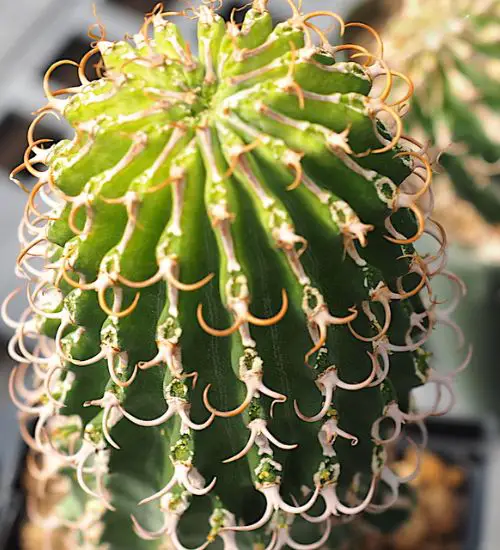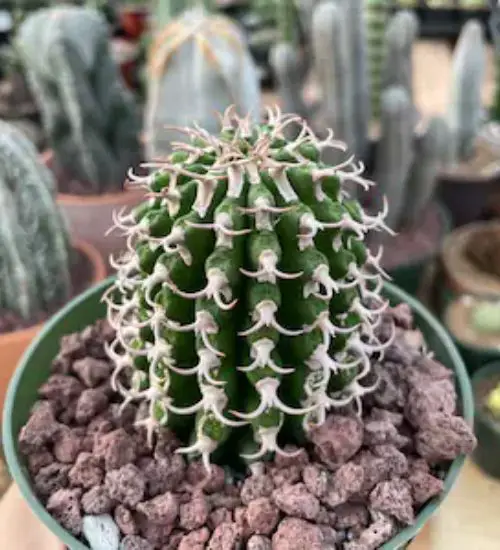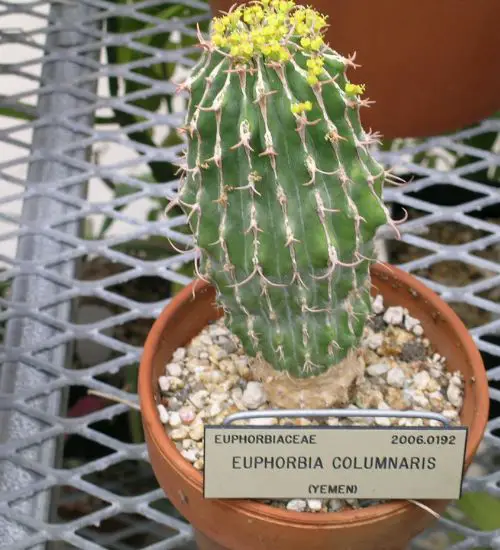Sun: Full sun to partial sun
Water: Typical water needs for a succulent
Temperature:
Winter Survival: Not cold hardy
Propagation: cuttings, grafting
Flower:
Flower Type: Yellow
Toxic: Toxic to humans and animals
Dormant: winter
Space Requirement: Indoors & Outdoors
Common Problems: pests
Where to buy Euphorbia Columnaris?
Basc Care for Euphorbia Columnaris
Watering
Can you water your succulent more than what its need? The answer is yes and no. In extreme conditions, you can water your plants more often when you notice the soil is completely dry.
One simple tip for you is that you can use some online apps to check the soil status before you go water your succulents. I would recommend the ThePlantsCheck app, it has some nice features there.
Fertilizing
Only feed this succulent during its active growing seasons which means winter. Use the right fertilizer applied in the right amounts. Applying half-strength balanced fertilizer every month or so is recommended for optimal results.
Do not fertilize during winter as the plant is dormant.
Sun & Location Requirements for "Euphorbia Columnaris"
Euphorbia Columnaris requires full sun to partial sun in order to grow its best. If your plant isn't getting at least 6 hours of direct sunlight each day, consider moving it outdoors during the summer months or near a south-facing window throughout the year. With enough light, you'll have a healthy and happy succulent!
As per this succulent profile, it is only able to stay healthy when the environment temperature is above the range of %temperature_label%.
In order to protect Euphorbia Columnaris from freezing temperatures, it is important to provide adequate insulation and drainage. A layer of mulch or gravel will help protect the roots by keeping them warm during cold weather. In addition, protection from wind and sun exposure can help reduce the chances of frost damage.
Any succulents in the group will need a medium space to grow. You can place your pot at your table or window. Since this plant needs more space than mini succulents, you should consider do not plant them together with other succulents/plants.
Propagation
One way to propagate Euphorbia Columnaris is by cutting
Grafting is an effective way to propagate Euphorbia Columnaris. It involves carefully cutting and splicing two plants together, creating a strong fusion between the two. This ensures that the plant can grow in a healthy manner, with minimal risk of damage to either part.
Toxicity

All parts of Euphorbia Columnaris are considered to be poisonous, and should never be ingested. Even contact with the sap can cause serious skin irritations in humans and animals, so it’s important to wear gloves when handling them.
Pests and Diseases
Euphorbia Columnaris can be affected common pests and diseases like most of the other succulents such as mealybugs, scale insects, and Red spider mites.
If you do spot any of pest signs, you can treat your succulent using below methods.
- Mealybugs: quarantine, clean infected plants, soapy water.
- Scale insects: quarantine, clean infected plants, soapy water.
- Red spider mites: Quarantine, clean your infected plants, treatment with a systemic insecticidal/soapy water.
Besides that, to prevent serious health issues from happening, keep your succulent in a well-ventilated area and check it regularly for any signs of pests or health problems.


